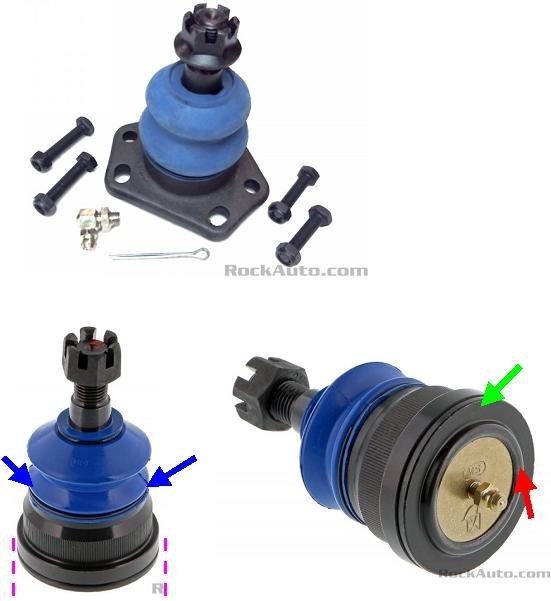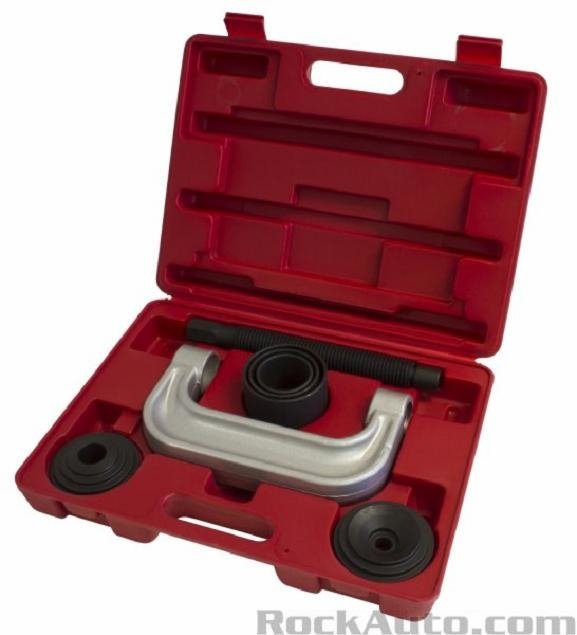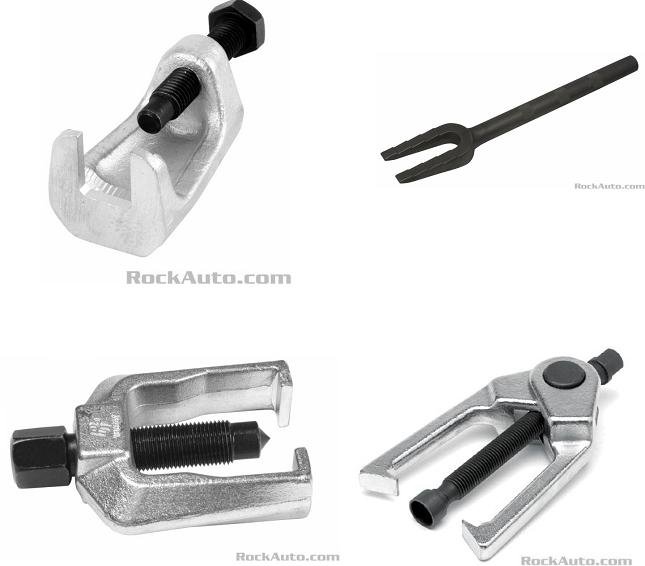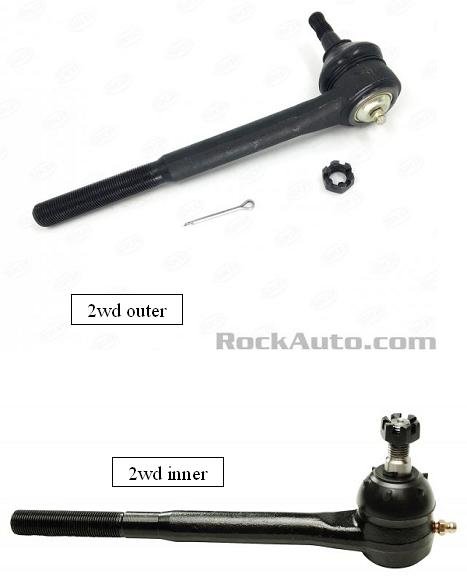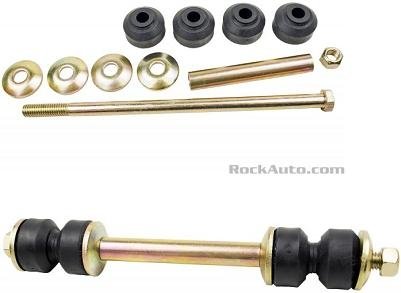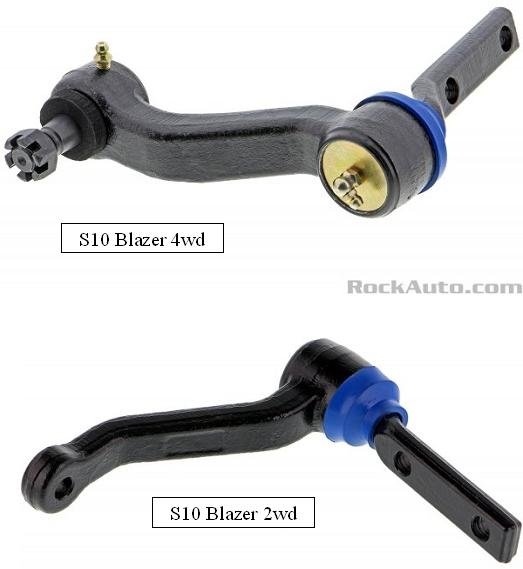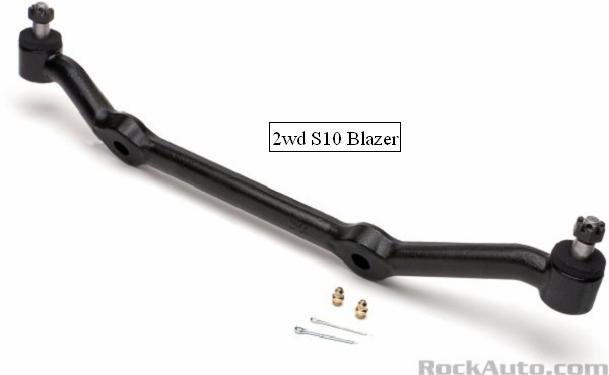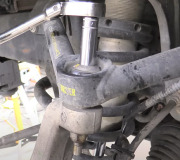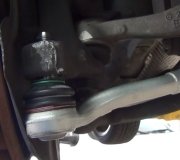Okay; now, with those corrections out of the way, to continue;
Tie Rod Ends and Adjuster Sleeves
Adjuster sleeves do not have to be replaced unless they're bent, but when replacing both tie rod ends, most professionals will use a new sleeve because their very low cost is less than the added cost of labor time to prepare a used one for reuse. When you're replacing just one tie rod end, there are special sockets for use with an impact wrench to make the job go faster. The problem is the pounding is going to be absorbed by the ball and socket in the other tie rod end that isn't being replaced. These joints are physically very small in relation to the forces acting on them, so it's real common to find all four of them have unacceptable looseness when you squeeze them. The pounding from air tools isn't going to help an end that is going to remain in service.
One trick is to loosen the clamp bolt for the end being replaced, then use an air hammer to drive a chisel bit into the sleeve's slot, and expand it. Now remove the tapered stud, and you may find you can unscrew the tie rod end by hand. Even if you do resort to the impact wrench, the stress on the other end will be a lot lower.
If it hasn't occurred to you yet, the threads on one tie rod end are going to have normal threads, and one will have backward threads. When looking at the threads in the sleeve, you are going to be sure you can tell which end has the backward threads, and there's a fifty percent chance you'll be wrong. I've been tricked many times when the tie rod end wouldn't screw into the sleeve. Don't go by looks. Instead, unscrew just one of the ends first, then screw the new one in before you remove the other one. That will eliminate any confusion.
Standard practice is to count the number of revolutions needed to unscrew an end, then run the new one in the same number of turns. In actual practice, that will only get you close. You can't know if an aftermarket manufacturer decided to cast their part a quarter inch longer or shorter, or even if the original one was a standard length. GM may have made the original parts in-house, or they could have bought them from multiple suppliers. The number of turns has no relevance because this link comprised of the sleeve and two tie rod ends is one of the two final "toe" adjustments. Once all the other alignment angles are set, the steering wheel is locked perfectly straight ahead, then these sleeves are turned to adjust their length, thereby adjusting each wheel to also be straight ahead.
If you didn't count the number of turns each tie rod end was screwed into the sleeve, run the new ones in 27 turns. That will get you real close to the final correct length. Also be sure to run both in the same distance. I've never found two tie rod ends to have different thread pitches, but if that were a design variable, it would mean one of them needed to be screwed in more or less turns to get it in the same length as the other one. By having both run in the same amount, it insures one of them won't run out of threads if the sleeve has to be turned a lot to get to the desired toe setting.
It's okay to put a little axle grease on the threads to prevent them from rusting to the point it takes two men and a boy to turn one during a future alignment. I use Spray White Lube to insure the sleeves stay freed up. Never use penetrating oil, especially Chrysler's "Rust Penetrant". That stuff works real well, but it opens up the way for moisture to sneak in after it. That moisture causes the sleeve to rust even tighter months later. Regular grease and oil won't do that. Also never use any type of anti-seize compound on these threads. That stuff is too slippery. The fear is a hard impact could let the threads jump, or even worse, two parts could pull apart.
Once two tie rod ends and the sleeve are assembled, that entire link can be installed either way on most older rear-wheel-drive Chrysler products. From the factory, you don't know if the tie rod end with the normal thread is the inner one or the outer one. The only issue with that is you don't know right away which way to turn the sleeve when you need to adjust toe on that wheel, until you try it. You can't switch them on most older Fords because the inner and outer ends have seriously-different lengths, and they have bends in them for clearance from other parts. The link can also be switched on GM cars and light trucks, but on all of these vehicles it is customary to make the normal-threaded end the outer one. One way to tell the ends apart on GM vehicles is by the location of the grease fittings. One comes out the bottom of the housing and one comes out the end of it. If the entire assembly is turned around, it is possible one of the grease fittings could hit the control arm as it moves left and right. Typically that causes the grease fitting to be knocked off, and nothing more.
No torque spec is listed for the castle nuts on the tie rod ends, so again, rely on common sense. These are smaller nuts than those for the ball joints, so expect their torque spec to be a lot lower. It's irrelevant anyway on most models because the nuts are on the back side of the center link where you can't get a socket on the inner ones, so you can't use a torque wrench without a hard-to-find special adapter. Even getting a box wrench on them can be difficult. Expect these nuts to take around 20 � 30 foot � pounds, which is easy to achieve with an open-end wrench, then, as before, tighten them just enough more so you can get the cotter pins in.
There's one last thing we have to watch out for related to a pair of tie rod ends. When the linkage is installed and the clamp bolts are tight, if you grab the sleeve and try to rotate it, you'll see the tie rod ends can swivel between the balls and sockets. That freedom to do so is important to allow that movement to take place when the wheels turn left and right, and as the suspension travels up and down. If the two ends are clamped at opposite ends of that travel, the assembly won't be able to swivel. The resulting binding can make it hard to turn fully one way, and repeated twisting of the sleeve can lead to it cracking and breaking. All you need to do to avoid this is to be sure the assembly can be swiveled once the clamp bolts are tight. The alignment specialist is going to check for that when he makes the last two adjustments.
All of the parts up to now must be replaced or must be in good condition for the vehicle to be aligned. They all are responsible for holding a wheel in a certain orientation, either tipped or turned. We're supposed to inspect all of these parts before starting an alignment, and knowing the alignment can't be maintained with a worn part on the vehicle, a conscientious mechanic will not take your money for an alignment or attempt to perform it. It's also proper etiquette to inform the specialist of the new parts you installed and any other services you performed. He is still going to inspect your work so he feels confident when putting his name on the repair order. By double-checking your work, you will also have the confidence to trust the final product.
Outer Anti-sway Bar Links
These are of a real common design found on various models from every manufacturer. They fail in two ways. One is when the bolt rusts apart in the middle. Most often that occurs right near the end of the sleeve in the middle of the assembly. The truck body will tip more than usual when cornering at high speeds, and there may be a banging or crunching noise if the two parts hit against each other.
The second failure is when the rubber bushings dry-rot and split apart, then fall off. You'll hear the classic rattling "tambourine" sound when driving over bumpy roads. That's from the washers on the link. Other than slightly reduced cornering comfort, these broken links do not cause a safety hazard. They do not have to be replaced for the truck to be aligned.
Removing the links is harder than it looks. The sleeve is usually rusted to the bolt, but it has to be slid off. Instead, some people use a torch to cut them off. I use an air-powered cutoff tool to cut off the head of the bolt, and then cut through the nut. When you install a new link, the threaded end can go on top or on the bottom, as long as the threaded end doesn't interfere with and hit other parts.
There's two things to be aware of to help this job go better. The first is when you're replacing both outer links, slide in both bolts with their first two washers, two rubber bushings, and sleeve, then the next washer and bushing. I use a rubber band to stop the bolt from sliding out on one side while I assemble the other side. Now swivel the bar up so both bolts go through the other holes, then install the last bushings, washers, and nuts. As an alternative, you might get away with totally assembling one link with the nut just started, then do the other one. The problem is when you fully install one link and tighten the nut, you won't be able to pull the bar far enough to allow the parts to be assembled on the other side. Even two men pulling on the bar will need two boys to help.
The next hint has to do with how far to tighten the nuts. Some people will tighten them as much as possible, but that crushes the bushings so much that they won't be able to flex as the bar moves around. That will reduce the life of the bushings to almost nothing. Proper procedure is to watch the bushings expand as you tighten the nut. Stop tightening it just when the bushings have expanded to the same diameter as the washers, and no more. This will leave them with just the right amount of flexibility and free movement.
Most older GM trucks and rear-wheel-drive cars also used a threaded stud at the top of the front shock absorbers. They use the same type of bushings and washers. Those are also tightened the same way until the bushing diameter matches that of the washers. When removing the old shock absorbers, unscrewing the nuts can be very frustrating and time-consuming. To make this job easier, if those old shock absorbers are being discarded, with a simple trick, both shock absorbers can be replaced in less than five minutes;... Okay, maybe ten minutes. Use a high-quality six-point deep socket that fits the nut perfectly. Due to normal rust buildup, you'll likely have to tap the socket all the way on. Now attach a long extension, and use it as a handle to bend the nut and stud back and forth until it snaps off. Due to the pressure of the compressed bushings, the nut will pop when the stud breaks. Often it only takes a few bends for the stud to give up and break. If it doesn't want to break, or if you can't bend it both ways far enough due to hitting the brake master cylinder or some other obstruction, just bend the stud as far as possible, then use the impact wrench to spin the nut off. Bending the stud will prevent the unit's shaft from spinning.
Coil Springs
The last thing that is critical for a quality alignment but always overlooked is correct chassis ride height. In the '60s and '70s, all Chrysler cars used easily-adjustable torsion bar springs. GM used a similar design on some of their truck models, but only on the four-wheel-drive models. Two-wheel-drive trucks don't have interfering front half shafts, so they can still use coil springs.
Every tire and alignment shop has a small book that lists every car and light truck model and year, where to take the height measurements, and what they should be. When the vehicle's height has sagged below the specified acceptable range, the only option with coil springs is to replace them. If you need to do that, the shock absorbers and outer anti-sway bar links have to be removed, then GM's procedure involves separating the lower ball joint, then prying the lower control arm down a lot. The bottom of the spring sits in a pocket, so it takes a second person with another pry bar to pull the spring out. You can still expect the spring to be under tension and go flying. This is a dangerous procedure.
My method is a lot easier and safer, but it's rather difficult if you have to do it on the ground. I do it on a hoist along with a special post jack that reaches up about four feet. The shock absorber still has to be removed, but not the anti-sway bar link, or even the wheel and tire. Support the lower control arm between the two pivot bolts. With the vehicle's weight removed, the two pivot bolts can be removed. Lower the jack and the spring will extend with it. By the time the control arm is lowered about four inches, all the spring pressure will be removed. Pull the control arm down with one hand, and lift the spring out with your other hand. It can be helpful to have another person pull out on the bottom of the tire, but you'll only need his help for half a minute.
Clean out the dirt and small rocks in the pocket the bottom of the spring sits in. Those pebbles can cause a slight crunching noise for a little while, but what's more important is the new springs have a special rust-resistant coating. The rocks will scratch that coating, leading to early failure. In fact, it's common to find the lowest loop of the spring cracked off, then the vehicle will drop about an inch. We typically reach up in there to feel for that break, but be careful as the ends by the break are usually sharp and will cut your finger. Also look for rusty springs where this coating has been gone for a long time. Hondas are noted for the springs breaking right in the middle, then one of the sharp ends tears through the inner side wall of the tire.
There is a rubber sound isolator that sits on the top of the coil spring. Those usually keep falling off when you lift the new spring in place. Use string or discarded electrical wire to tie the rubber to the spring. That will prevent it from falling off.
If your alignment specialist knows what he's doing, he is going to measure ride height before agreeing to align your truck. To see why this is so important, look at how the lower control arm is nearly perfectly parallel to the ground, and the upper control arm is angled down a lot toward the upper ball joint. (This puts the upper ball joint's stud at a severe angle relative to the housing, which is what leads to their recurring failure). The spindle and the frame make up the last two parts that form a parallelogram with very specific angles designed in. This suspension system is called the "short-arm / long-arm", (SLA) system. It provides the best possible ride comfort because road shock has to change direction multiple times as it passes through the parts before a little that's left finds its way into the body. The disadvantage is it's heavy, uses a lot of parts, and is expensive, so you don't see it much any more except in larger trucks.
The two control arms travel through very specific arcs as they pivot up and down. For the most part, as the lower arm moves up and down, the ball joint moves left and right very little. The upper control arm, on the other hand, swings through a much different arc. As the truck body moves down, the upper arm swings up, and that ball joint moves outward a real lot. That tips the wheel and tire, and reduces how much the tire slides sideways across the road surface. That tipping greatly reduces tire wear. Other than vehicles that use a solid front axle, only Ford's I-beam suspension system is stronger, but that system, and even worse, their miserable twin I-beam system, give the worst tire wear of all the suspension systems. With the twin I-beam system, that poor tire wear gets much worse as the springs sag. There are special offset ball joints, and inserts with offset tapered holes, to correct these height-related problems, but the proper solution is to replace the springs.
While ride quality is best with this SLA system, tire wear is only best when the parallelogram angles are as designed, and that can only be when ride height is correct. As the springs sag with age, both control arms pivot upward at their ball joint ends. The lower ball joint doesn't move outward very much, but the upper one moves a real lot. That outward tilt of the spindle and wheel, (camber), can be readjusted. Caster and camber are always the first two of the three main angles adjusted. But while camber can be brought back to specs, that doesn't fix the incorrect geometry of the control arms or the arcs they go through. Even though all the numbers on the alignment computer look perfect, there will definitely be accelerated tire wear when the springs are sagged.
These photos show the parts for your model. In the first one, note the different placement of the grease fittings between the inner and outer tie rod ends. The second one shows the anti-sway bar outer link. In the third photo, you can see the idler arms are different for the two-wheel-drive and the four-wheel-drive models. For your two-wheel-drive model, you only have to look for wear at the swivel joint under the blue boot. When pushing the end of the center link up and down, there should be very little movement. In this application, the ball and socket is on the end of the center link. Note the deep offset of the mounting bar just above the dust boot. On some models that bar can be spun around and be bolted to the frame that way, but that is not correct. The bar should follow the curve at the bottom of the frame rail. The last photo shows the center link for the two-wheel-drive model. There was no listing for the four-wheel-drive, but it won't have the ball and socket on the idler arm end.
For my final note of value, a squeak can be caused on this model by the coil spring rubbing on the pocket in the lower control arm and / or up on top. Some trucks didn't come with the rubber isolator on top. There was a service bulletin that stated those isolators were to be installed above and below each spring to stop that noise, (four spacers per truck).
Images (Click to make bigger)
Friday, November 22nd, 2019 AT 4:13 PM
